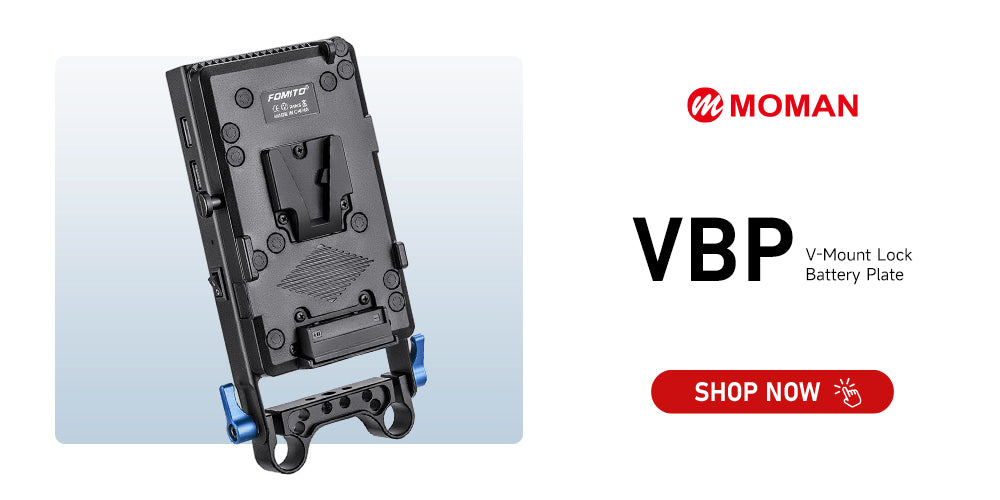For filmmakers frustrated by expensive, short-lived OEM camera batteries, V-mount batteries offer a cost-effective, high-capacity solution. They typically offer higher capacity than standard camera batteries, ranging from 90Wh to 290Wh or more. This extended power capacity makes them ideal for professional productions where battery changes would disrupt critical filming moments.
If you're looking to upgrade your camera system with V mount battery capability, understanding the role of a V mount battery holder is essential for a successful setup.

What is the purpose of a V-mount battery holder?
A V-mount battery holder—also known as a V-mount plate or adapter—serves two essential functions:
👉 Mounting Stability: It provides a secure connection point for the V-mount battery on your rig (cage, rods, or tripod), keeping your setup balanced and organized.
👉 Power Distribution: Many holders also function as adapter plates, converting the battery’s output (e.g., D-Tap, USB, DC) into multiple ports for camera and accessory power.
What types of V-mount battery adapters can you choose from?
Based on where you need to mount the battery and which devices you plan to power, here are five common options.
Crab-Style Clamp (Rod/Stand Clamp)
Often referred to as a “crab-shaped clamp,” this is a compact and budget-friendly option. It features a spring-loaded clamp that mounts onto rods, light stands, monopods, or rails—typically accommodating diameters up to about 4.2 cm (1.65 in). One popular example is the Moman VBC, which uses durable aluminum alloy for strength and lightness. It's best suited for simple setups where you just need to secure a V-mount battery without any additional power distribution.
15 mm Rod-Mounted Plate
More versatile than the basic clamp, this type uses dual 15 mm rod clamps to attach neatly to standard camera rigs. A well-known example is the Moman VBP plate, which not only mounts securely to workhorse setups but also provides multiple power ports—including USB, D-Tap, and several DC barrel outputs—for powering accessories like monitors, lights, or microphones. This setup is ideal for filmmakers who need a centralized power distribution solution built right into their rig.
Multi-Output Adapter Plate
An evolution of the rod-mounted plate, this holder adds advanced power management. Many such plates include various output ports (USB, D-Tap, DC barrel) and may even convert voltages across outputs. Again, the Moman VBP is a prominent example with wide-ranging pinouts and included cables for diverse gear support. These adapters are perfect for complex setups where multiple devices must draw power off the same V-mount battery.
Dual-Bay (Hot-Swap) Battery Plate
Designed for extended shooting durations, hot-swappable dual-bay plates hold two V-mount batteries simultaneously, enabling seamless transitions when one runs out of charge. The Moman DVBP, for example, offers this functionality plus dual D-Tap outputs and an LED low-voltage indicator. These are ideal for long-form shoots, professional cinematography, or setups where avoiding downtime is critical.
Belt Clip or Cheese Plate
Less common but incredibly useful in mobile or unconventional shooting scenarios, these types include:
Belt Clip: Allows you to carry the V-mount battery on your belt, keeping your hands free and avoiding cluttered rigs.
Cheese Plate: A flat, multi-threaded plate that lets you rig a battery firmly while offering multiple attachment points for modules, cables, or accessories—especially helpful for charging entire kits or integrating power distribution on static setups.
How to use a V-lock battery holder to power your camera system?
Here’s a clear, step-by-step process:
Step 1: Mount the Adapter Plate
>>Attach it to your rig—either via 15 mm rods, cage, or if compact, slide into a belt or attach with clamps.
>>Adjust its position for proper balance and ergonomics.
>>Ensure screws and clamps are snug to avoid movement.
Step 2: Insert the V-Mount Battery
>>Slide the V-lock battery into the plate until it clicks and locks securely in place.
>>If available, rotate the plate backward (e.g., 90° or 180°) to clear your camera’s flip-out display.
Step 3: Connect Power to Your Camera
>>Use the appropriate power cable: typically D-Tap to dummy battery cable or D-Tap to DC/USB input, depending on your camera model (e.g., BMPCC needs D-Tap to 2-pin).
>>Make sure both battery and camera are turned off during setup to avoid surges.
Step 4: Test Power and Troubleshoot
>>Turn on the battery and camera. If power fails:
>>Verify battery charge and switch position.
>>Ensure cable plugs are fully seated.
>>Confirm voltage and polarity are compatible.








